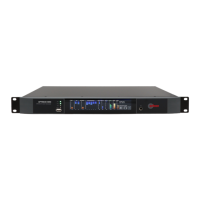6-12 Technical Data
(To ensure this, never modulate the carrier with a single L+R tone that produces total carrier modulation, including
pilot tone, of more than 24%.)
About the Multiplex Power Controller’s Time Constants
Although the BS412 specification calls for a 60-second integration time, the integration time of the Optimod’s MPX
power controller is about 10 seconds. The problem with making the integration time longer is that the BS412
standard states that the integrated MPX power in any arbitrary 60-second time period cannot exceed the average
power of the sinewave that produced 19 kHz carrier deviation. In other words, whenever you start measuring, you
must not exceed the total integrated power limit over the following 60 seconds.
This makes it impractical to "bank" power over the full 60-second window. For example, at first glance one might
think that a classical music station could exploit a period of quiet music to allow a crescendo to get louder than it
would using the 5950's relatively fast integration time. However, what happens if someone starts an arbitrary 60-
second measurement period not at the beginning of the quiet passage but at the beginning of the crescendo?
Because an automatic MPX power controller does not know what is coming after the crescendo, it must reduce the
level of the crescendo so that it complies with the MPX power requirement over an integration time that is shorter
than 60 seconds. Otherwise, it might have to dramatically reduce the level of following (as yet unknown) program
material in order to ensure that the MPX power limit is not exceeded over the 60-second measurement period in
question. This kind of gain pumping would be far worse than the pumping produced by using a relatively short
integration time.
MPX Pwr Ctrlr Gate: To minimize audible side effects of the MPX power controller’s gain reduction, its release time
is dual-speed and changes as a function of the audio level: if the audio level is below a preset threshold, the slower
time constant activates. There are five preset values for the gating, which set the level below which gating occurs,
as well as the release times above and below the threshold. Higher-numbered presets provide slower release times
both above and below the gating threshold.
Unlike the 03;
32:(57+5(6+2/'control (a System control), the 03;3:5&75/5*$7( control is part of the
active processing preset.
Preset 0: No gating: Works like Orban’s older, non-gated MPX power controller.
Preset 1: Only the quieter passages are gated and the gated release is faster than it is in the other presets. Created
to maximize loudness within the BS.412 limit while providing more on-air dynamics and preventing
unnecessary gain pump-ups.
Preset 2: A compromise between Preset 2 and 3. Works well with more dynamic, more open-sounding presets.
Preset 3: Recommended for most CHR-style presets. Quieter parts of the music are effectively frozen to achieve
less audible BS412 control. It is still possible to stay at the BS.412 limit most of the time.
Preset 4: A general-purpose preset that works well with most processing presets. When on-air processing preset is
designed well, it is still possible to stay at the limit with nearly inaudible BS412 control up to 2dB gain
reduction.
Preset 5: The controller gates on nearly every power-drop so that the release rate is almost always very slow.
Designed to act only as a protection limiter to sound nearly like no BS412 controller is working at all while still
getting loudness benefits from it. BS.412 gain reduction of up to 3dB is possible without objectionable side
effects.

